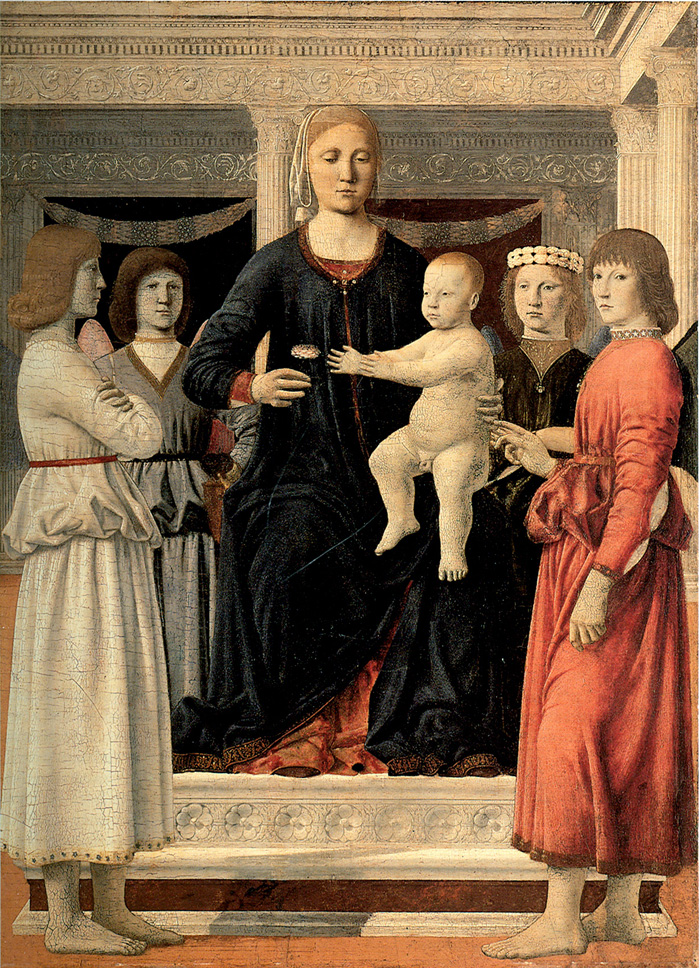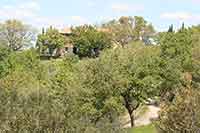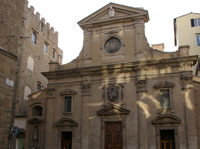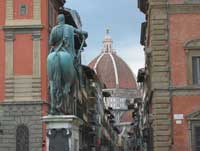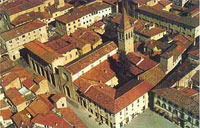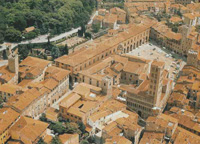
[1] This extremely rare painting by a key figure of the early Renaissance in Italy was one of Sterling Clark's first purchases. The collections of the Clark Art Institute are the achievement of Robert Sterling Clark (1877-1956), a Yale engineer whose forebears had been successful in the sewing machine industry. Clark began collecting works of art in Paris in 1912, married a French woman named Francine, and eventually housed his masterpieces in a classic white marble temple here in Williamstown.
The original museum was greatly expanded in 1973, and now has strong collections of paintings by the Impressionists, their academic contemporaries in France, and the mid-century Barbizon artists, including Millet, Troyon, and Corot. Earlier centuries are represented by well-chosen pieces of Piero della Francesca, Memling, Gossaert, Jacob van Ruisdael, Fragonard, Gainsborough, Turner, and Goya. There are some sculptures, including Degas' famous Little Dancer of Fourteen Years, as well as prints, drawings, and noteworthy collections of silver and porcelain.
www.clarkart.edu
[2] "Battisti (1971, p. 64) reconstructs the ownerships, going back to the Christie's sale on 29 May, 869 where the provenance is given as the Gerardi (or Gherardi) house in Sansepolcro. Battisti recalls that in 1583 a painting attributed to Piero della Francesca was to be found in the house of a ']acomo di Bernardino Gherardi' in Sansepolcro. The painting reached Williamstown in 1957. Battisti publishes the opinions of experts on the work's 'excellent state of conservation'. Longhi instantly judged the work to be 'a masterpiece by Piero', noting that it was not mentioned in Toesca's 1935 article, if not as 'vaguely known'. (...) Of works closely related to Piero della Francesca this is no doubt the finest example, which acutely emphasizes our lack of both knowledge and interpretative models for the school of Piero. The school must have had numerous adherents ready to re-elaborate the master's suggestions and ideas. Piero's theoretical writings show a pronounced inclination towards teaching. The variety of artists influenced by him, from iSignorelli to Michelozzo, Antoniazzo and Lorenzo da Viterbo is comparable only to Leonardo's wide circle.
The panel reveals a genuine anthology of citations from the known work of the master and of those near to him, crowded in a similar way to that experienced in some pictures by Leonardo' s pupils. Regardless of the supposed provenance from Sanscpolcro, the work is dominated by
Piero's Urbino themes, even if Hendy attributed the 'stiffness and clumsiness' he saw in the picture to Piero's youthful years.
The angel with crossed arms seen in profile, a type probably initiated in the Perugia Annunciation, is taken up again in profile, in reverse, in the Christ Church Madonna with Child and Angels. The penultimate angel on the right is a faithful citation, even to the back lighting of the hair, from the first angel to the right of the Madonna in the Montefeltro Altarpiece. The veil of the Madonna's he ad is a linear translation of the voluminous veil in the Senigallia Madonna. The three-quarter view face of the angel on the extreme right corresponds to the one on the extreme right in the same Senigallia painting, though with the addition of a fringe, and above all without the spiritual rapture of the model, which has been replaced by an attitude of open seduction towards the spectator."
Carlo Bertelli, Piero della Francesca, New Haven & London, Yale University Press, 1992, p. 228.
|

Art in Tuscany | Giorgio Vasari's Lives of the Artists | Piero della Francesca
The Metropolitan Museum of Art - Special Exhibitions - From Filippo Lippi to Piero della Francesca: Fra Carnevale and the Making of a Renaissance Master
Florence: Filippo Lippi and Fra Carnevale | The Metropolitan Museum of Art | www.metmuseum.org
This essay, written by Keith Christiansen, was derived from the exhibition catalogue From Filippo Lippi to Piero della Francesca: Fra Carnevale and the Making of a Renaissance Master (The Metropolitan Museum of Art, New York, 2005).
'The biography of Fra Carnevale takes us from Medicean Florence to Urbino, in the Marches, ruled by the great soldier-patron Federigo da Montefeltro. It involves some of the great names of quattrocento art: Filippo Lippi, Domenico Veneziano, Luca Della Robbia, Donatello, Michelozzo, and Piero della Francesca. And it embraces such key issues as: what we know about workshop practice; what we mean by artistic influence; and—most important—how fifteenth-century painters created an artistic identity and used that identity to assert their claims to the emerging concept of creative genius.
The exhibition unfolds in three chapters. The first is set in Florence in the 1440s and explores the workshop of Filippo Lippi, where Fra Carnevale is documented in 1445. The second casts a glance at some of Fra Carnevale's compatriots: artists who, like him, traveled to Florence from the Marches to acquire the rudiments of Renaissance practice and then returned to their native towns. Their curiously hybrid pictures—sometimes astonishingly imaginative—provide a meter by which to judge the achievement of Fra Carnevale. The concluding chapter unites the surviving works by Fra Carnevale with Virgin and Child Enthroned with Four Angels by Piero della Francesca, whose shadow falls across Fra Carnevale's finest paintings and epitomizes the artistic culture of Urbino.'
|
![]()

